

Norway(*) Nation(*) Africa(*) Collections. Fantasy Worldbuilding Questions. Google Sketchup Terrain Tutrorial. Google Image Result for. Google Image Result for. Number of Trees per Acre by Spacing. Kim D.
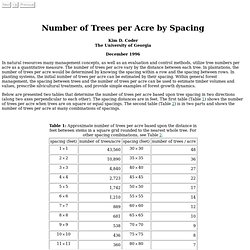
Coder The University of Georgia December 1996 In natural resources many management concepts, as well as an evaluation and control methods, utilize tree numbers per acre as a quantitative measure. The number of trees per acre vary by the distance between each tree. In plantations, the number of trees per acre would be determined by knowing the spacing within a row and the spacing between rows. Below are presented two tables that determine the number of trees per acre based upon tree spacing in two directions (along two axes perpendicular to each other). Globus Cassus. Globus Cassus is an art project and book[1] by Swiss architect and artist Christian Waldvogel presenting a conceptual transformation of Planet Earth into a much bigger, hollow, artificial world with an ecosphere on its inner surface.
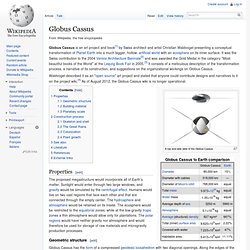
It was the Swiss contribution to the 2004 Venice Architecture Biennale[2] and was awarded the Gold Medal in the category "Most beautiful books of the World" at the Leipzig Book Fair in 2005.[3] It consists of a meticulous description of the transformation process, a narrative of its construction, and suggestions on the organizational workings on Globus Cassus. Waldvogel described it as an "open source" art project and stated that anyone could contribute designs and narratives to it on the project wiki.[4] As of August 2012, the Globus Cassus wiki is no longer operational. Properties[edit] The proposed megastructure would incorporate all of Earth's matter. Geometric structure[edit] Building material[edit] Planetary scale[edit] Construction process[edit] Book cover. Transforming the Earth. Humanity's home is far from factory-fresh these days.
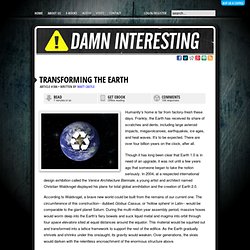
Frankly, the Earth has received its share of scratches and dents, including large asteroid impacts, megavolcanoes, earthquakes, ice ages, and heat waves. It's to be expected. There are over four billion years on the clock, after all. Though it has long been clear that Earth 1.0 is in need of an upgrade, it was not until a few years ago that someone began to take the notion seriously. In 2004, at a respected international design exhibition called the Venice Architecture Biennale, a young artist and architect named Christian Waldvogel displayed his plans for total global annihilation and the creation of Earth 2.0. Of course it would be easy to dismiss the idea as ridiculous fantasy, one belonging only on the pages of the very pulpiest science fiction. Globus Cassus under construction The design appears commendably thorough. Yet curiously there are numerous objections to the concept.
Stanford Torus. Culture Collision. THEME: Timber Creek SUBJECT AREA: Education for Sustainable Development (ESD) TOPIC: European expansion for cattle ranching “Natives are numerous on Victoria and Ord and are very treacherous, a fine race and very independent”.

Lindsay Crawford 1885. European exploration of Africa. European exploration of Africa began with Ancient Greeks and Romans, who explored and established settlements in North Africa.
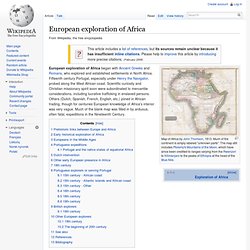
Fifteenth century Portugal, especially under Henry the Navigator, probed along the West African coast. Scientific curiosity and Christian missionary spirit soon were subordinated to mercantile considerations, including lucrative trafficking in enslaved persons. Others (Dutch, Spanish, French, English, etc.) joined in African trading, though for centuries European knowledge of Africa's interior was very vague. Much of the blank map was filled in by arduous, often fatal, expeditions in the Nineteenth Century. Prehistoric links between Europe and Africa[edit] The connection between Europe and North Africa is older than recorded history. Sataspes. Sataspes was a Persian navigator and cavalry commander whose name is derived from Sat (=100 sad) and Asp (= Horse, Asb).
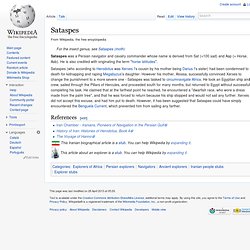
He is also credited with originating the term "horse latitudes". Sataspes (who according to Herodotus was Xerxes I's cousin by his mother being Darius I's sister) had been condemned to death for kidnapping and raping Megabyzus's daughter. Prester John. The legends of Prester John (also Presbyter Johannes) were popular in Europe from the 12th through the 17th centuries, and told of a Christian patriarch and king said to rule over a Christian nation lost amidst the Muslims and pagans in the Orient.

Written accounts of this kingdom are variegated collections of medieval popular fantasy. Prester John was reportedly a descendant of one of the Three Magi, said to be a generous ruler and a virtuous man, presiding over a realm full of riches and strange creatures, in which the Patriarch of the Saint Thomas Christians resided. His kingdom contained such marvels as the Gates of Alexander and the Fountain of Youth, and even bordered the Earthly Paradise. Among his treasures was a mirror through which every province could be seen, the fabled original from which the "speculum literature" of the late Middle Ages and Renaissance was derived, in which the prince's realms were surveyed and his duties laid out.[1]